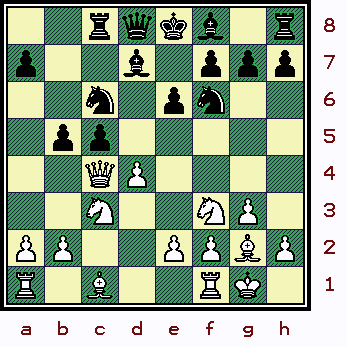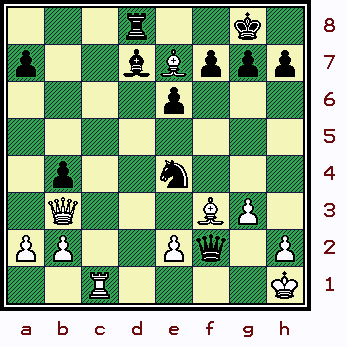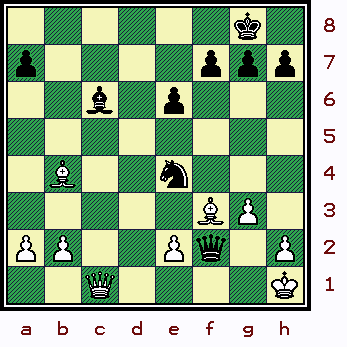All
the |
(Navigation bar
directly below.)
*******
© A.J. Goldsby, 2015.
(All rights reserved.)
****************
Click HERE
to see my
Chess Items.
****************
****************
Buy a book
from Amazon.com
(And help me out as well!)
****************
Click HERE
...
to see a list of the businesses that help to sponsor all of
my chess efforts.
Hug - Korchnoi;
National Team Championship(s) Tournament
Zurich, Switzerland; 1978.
This is a game I remember seeing - prolly in "CL&R" - right after it was played. It is in many books as well, I have also found it in many books ... and even a few {old} magazines.
Korchnoi is a great player, I think I have just about every book or pamphlet, (about 10-15); on him that was ever printed in English. (And even a few in other languages!) Probably in terms of {chess} longevity, a high playing level and good results, (spread over SIX decades!!); this player is in a class ... ALL BY HIMSELF!
Click
HERE
to see an in-depth and complete explanation of all the symbols ... ...
...
that I normally use when annotating a chess game.
Click HERE to see (and replay) this game on a JS-script board. (NOT my site!!)
IM
W. Hug (2459) - GM
V. Kortchnoi (2761);
[A04]
National Team Championship
Tournament
Zurich, Switzerland, 1978.
|
A friend and I, (S. Davis); looked at this game last night at chess club ... several club members were also looking on. This game brought everyone,
(who was present and watching us); so much pleasure ... that I thought -
without delay - I would share it with chess-players everywhere ...
via the vehicle of the Internet. ***************************************************************************** < Brief Biographies >
Vicktor
Lvovich Kortschnoj
was born in Leningrad, (USSR/RUS); on July 23rd, 1931. As soon as the war ended, a fairly young teenager (15-16); he became actively involved in organized chess in the {former} USSR. It is entirely possible that we might have seen his star shine sooner, but not for the tragedy of the 2nd World War. (We first see him play in the National Junior Championships in 1946. Korchnoi finished in 11th place - behind the winner, and eventual World Champion, Tigran Petrosian.) GM V. Korchnoi is a well-known player. From the period of the later 1950's, to the early 1990's, he was one of the world's top competitors. He has won the title of Champion of the U.S.S.R. a total of four times. He has won more international tournaments than I care to count. (At nearly 74, some might consider him to be all washed up. But watch out! In 2004, he won the Second György Marx Memorial Tournament in Hungary by a full point.) In 1976, he defected from the {old} Soviet Union. For a while he lived as a Dutch citizen, he even won that country's national championship. Then later - he moved to Switzerland, and after living there for 14 years, he is now a full, naturalized citizen of that country. (He has also been Swiss Champion many times.) Korchnoi, (often spelled other
ways); is one of history's greatest players. He has played two World
Championship Matches, (with Karpov); and has also been involved in at
least eight Candidate Matches and has played in close to fifteen
Interzonals. He has also represented both Russia and Switzerland in the
Olympiads. Werner Hug, (born September 10th, 1952); was a young super-star when this game was played. Hug, was awarded the IM title in 1971 for his rather unexpected victory in the World Junior Championships. He also won the Swiss Championships in 1975, and has played in many international tournaments and events. ****************************************************************************** I remember when this game was first played, I may have seen it in a chess magazine somewhere. The ratings are relatively accurate, and come from the web site of the very respected statistician, Mr. Jeff Sonas. The game starts out first as a
Reti, then turns into a Black opening ... but with colors
reversed. 1.Nf3
e6; 2.g3 d5; 3.Bg2 c5; 4.0-0 Nc6;
5.c4!?, {Diagram?} However, Hug normally plays a full blown, reversed KID. His sudden change of heart may signal that he is nervous ... or does not believe his regular choice of opening system(s) can succeed against such an illustrious opponent. The move chosen by Hug will transpose either to an English, or maybe a Catalan Opening. [ The standard move is: 5.d3, {Diagram?} for the K.I.A. opening. ]
5...dxc4!?; ******* [ After the move:
5...Nf6;
{Diagram?} ( Or simply just 6.d3!?, ("=") )
Play could now proceed: 6...dxc4;
7.Ne5!? Bd7!?; 8.Na3 cxd4;
GM Vladislav Tkachiev
(2672) - GM Andrei Sokolov (2668); *******
6.Qa4!?,
[
Perhaps better is: >/=
6.Na3!,
"+/=" {Diagram?}
6...Bd7!?;
7.Qxc4 Rc8!?; [ Playable was: 7...Nf6!?; {Diagram?} with a fair game for Black. ]
Korchnoi says that White should
now play an immediate d2-d4! [ >/= 9.d3 Be7; 10.Be3, "~" ("+/=") ]
9...b5!?;
(What the heck???)
{See the diagram - just below.}
******************************************
******************************************
A position that fully merits a diagram.
Normally an advance like this only
works in a position where your
opponent has made a mistake ... [ Fritz prefers:
9...cxd4!?;
('!')
{Diagram?}
10.Qd3,
{'Box?'} *********************************************************************** [ Variation # 10W01.)
Much worse would be:
( Much less accurate is: </= 10...Nxd4!?; ('?!')
11.Qc4, "~" {Diag?}
11.Nd1[],
{Diagram?} ***
( Korchnoi only gave the following
line, which is clearly terrible:
12.Qb7?? Rc7; ("-/+") {Diagram?} ***
11...Bd6!;
"/+" {Diagram?} ***************************************************************** Variation # 10W02.)
Also not to be recommended for White would have ( </= 11.Qd3?? c4; "-/+" )
11...Rb8!;
{Diagram?} *** *** *** *** *** *** *** *** *** *** *** *** *** *** *** *** ***
(
Korchnoi provides the inferior
continuation here of: *******
( Obviously better was: >/= 13...Qxa7; 14.Nxa7
Ra8; "/+" *******
14.a4 Qb3;
"<=>" {Diagram?}
... ... ...
However - the simple truth is
that Ne5! gives White a powerful
attack ... *** *** *** *** *** *** *** *** *** *** *** *** *** *** *** *** ***
12.dxc5,
{Diagram?}
( Worse is: </= 12.Bd2? Rxb5!; 13.Ne5!? Rb4!;
12...Bxb5; 13.Qc2 Nd5!;
"/+" {Diagram?} ***********************************************************************
10...cxd4;
11.Nxd4 Ne5!; 12.Qd1,
12...Qb6!;
13.Bg5!? Be7; {Diagram?} [ Interesting was: 13...Nc4!?; "~" {D?} with good play for Black. ]
Now White could play Nf3!? ...
but the move chosen by Hug
here seems very logical. [ Korchnoi said it might be just
a little better ... and a little
sharper ... to play the move:
(He could be correct. However,
several computer programs that
I checked, see little
15.Nf3?!,
('?')
(hmmm) {Diagram?} Yet the move seems very much
inferior - and has an immediate
impact on the ******* [ Why not the very simple move
of >/= e3 here, when White seems
The following continuation -
which was meticulously checked
with the *******
The next few moves seem to
be best or forced for both sides. 15...Nxf3+;
16.Bxf3!? Rfd8; 17.Qb3!?, (hmmm)
{Diagram?}
I must say however, that:
In my own humble opinion, Qb3
was not worthy of the inferior mark
that Korchnoi gave it. '?!' - IM Charles Partos. (Informant # 26)
[
The following continuation was
fully playable for White. I.e., ( </= 18.Qe1?! Bxe4!; "=/+" )
18...Bxe4; 19.Bxf6 Bxf6;
20.Bxe4 Qd4; 21.Rxc8 Rxc8;
The computer thinks Black is
better, but over an hour's
worth
17...b4;
"=/+" ('!') Of this move, (...b4!); Korchnoi says: "Better late than never!" [ Interesting was: 17...a5!? ]
18.Ne4?,
(Ugh!)
The only question for me is:
Korchnoi makes the following
comment in this position:
[ A big improvement over both
the analysis ... AND the game
... ( </= 18...bxc3??; 19.Qxb6 axb6; 20.Bxe7, "+/-" )
19.Ne4,
(hmmm) {Diagram?} ( Not </= 19.Nb1?! Qd4!; "/+" )
19...Be7; 20.Rfd1!? Rxc1!;
21.Rxc1 Be8!!; 22.Rc2!? a5!;
18...Nxe4!; [ Less accurate would be:
White's reply is now forced ...
Bxe4?? just drops a piece to
the move, ...BxB/g5. [ Not </= 20.Bxd8? Qxf2+!; ("-/+") {Diagram?} and mate next move. ]
20...Qxf2+;
21.Kh1,
{See the diagram, just below here.}
******************************************
******************************************
And this position ... (which I
have
tested on many players in the rating
range of 1400-to-1900); ...
21...Rc8!;
(Maybe - '!!')
I give this move one exclam, and I
think it could deserve two. Most
authors give it at least one ... [ But not </= 21...Re8; as 22.Qxb4; "~" lets White off the hook. ]
22.Qd1,
{Box?} [ Variation # 22W01.)
White will lose in the following
continuation ... although it
requires Black ( NOT </= 23.Rxd2???, 23...Qf1#. )
23...Nf1!; 24.Bg2 Ne3;
25.Bf3, {Box.}
{Diagram?} ******* ( Not </= 25.Qxd7?? Qxg2#. *** *** *** *** *** *** *** *** *** ***
Or </= 25.Rg1?! Qxg2+!!; {Diagram?}
26.Rxg2 Rc1+!; ("-/+") {Diagram?} *******
25...Nxd1; 26.Qxd1[],
{Diagram?} ( </= 26.Qxd7?? Qf1# )
26...a5!;
("-/+") {Diagram?}
{I might have gotten a little
carried away with all the cute
mates, but the guys
***************************************************************** Variation # 22W02.)
White missed an apparent
refutation. But the refutation
has ... ******* After the following seemingly reasonable moves:
</= 22.Rxc8+ Bxc8;
23.Qd1, {Diagram?} ( Not </= 23.Bxe4???, 23...Qf1#. )
Now Black simply smiles, nods
his head, and plays:
And now after:
24.exf3 Nf2+; 25.Kg2 Nxd1;
26.Bxb4 Nxb2; {D?}
(In reality, White's 22nd move in
this line deserved a full question
22...Rxc1!!; But watch what Korchnoi does after this!!!
Korchnoi - modestly - gave his
19th move no mark at all; while
several different
[ But definitely
NOT:
</= 22...Re8???; 23.Qxd7,
"+/-" {Diag?}
23.Qxc1 Bc6!;
(Maybe - '!!')
I annotated this game first, then I
checked this game out in the
correct issue of the Informant.
24.Bxb4!?, (hmmm) {See the diagram - just below here.} White decides to snack on a Pawn ... maybe he thought his position was safe here?
******************************************
****************************************** {This is a good place for a diagram.}
At this point, NO ONE at the club could predict Black's next move. Actually, White's last move was
a really an error, ('?') albeit it occurred in a position that [ Variation # 24W01.)
The box seems to think White
has to put the Queen on b1 or
even a1 here.
But after the moves: >/=
24.Qb1!? a5!; 25.a3!? Nd2!;
26.Qd1 Bxf3+!;
28.Bxa3 h5!; 29.Bc5!? Qxf3+;
30.Qxf3 Nxf3; 31.b4 axb4; ***************************************************************** Variation # 24W02.)
White can also try:
</= 24.Qg1?,
{Diagram?}
But Black replies with: ( Not </= 25.Bxe2?? Nxg3#. - Charles Partos. Informant # 26 / Game # 28. )
Now - according to Fritz 8.0 -
the remaining moves are all
completely forced. ( Or the brutal 33...Qf1# . ) ]
Black to play ... what move would YOU make in this position??? 24...Qxe2!!; (WOW!!!) {Diagram?} (White Resigns.) ('!!' - IM Charles Partos.) ('!! - GM Victor Korchnoi.)
At first glance, it appears that
Black might have blundered.
But IM Hug thought for a little ********************************************************* [
The win is proved in the
following variations: ********************************************
a).
White gets incinerated
in the following line. Viz: ( Or '=' 27.Kh3 Qxg3#. ) 27...Nxg3# . (The end of the proverbial line.) *******
b). Its death and dishonor
(also!) after: ********************************************
25...Nxg3+;
{Diagram?}
26.Kg1 Nxe2+; 27.Kf1 Nxc1;
{Diagram?} *********************************************************
Personally ... I think IM W. Hug picked the perfect place to abandon ship. Its one of the reasons that this game has found its way into SO many anthologies and problem books. (Besides: Like I.A. Horowitz and Chernev used to say ... "There is no reply to a thunderbolt!") A wonderful game by Korchnoi. He played with passion, fire, great imagination, originality, creativity and also ... (Dare I say it?); ... tremendous brilliance, from start to finish of this wonderful clash. *********************************************************************
But the following were my main
sources for annotating this game.
# 1.) The INFORMANT (Volume # 26)
# 2.) "Korchnoi's 400 Best
Games," by GM Victor Korchnoi, R.G. Wade,
# 3.) "My Best Games,"
(Volume # 02: Games with Black);
by GM V. Korchnoi. (HB)
---> (I completed my {game} analysis, Friday;
August 06th, 2004.) Copyright (c) A.J. Goldsby I Copyright (c) A.J.G; 1979 -
2005.
0 - 1*************************************************** The game analysis - and the initial HTML code - was originally generated ... by the program, ChessBase 8.0. The diagrams were generated by the program, Chess Captor 2.25. |
If you enjoyed this
analysis, (or want to comment on it); and would like to contact me ... this is
my contact information:
A.J. Goldsby I (LifemasterAJ@yahoo.com)
P.O. Box 11718; Pensacola, FL 32524 (USA) [more]
The way this game is presented here is pretty much the way that I developed it in my ChessBase files. I shortened a few variations ... they were unnecessarily long. (I also altered the CB document to match what you see here.) If some variations look to be longer than what you might think is required, I had to disprove what other writers - like Korchnoi - had written.)
In the end - I am now very happy with this game. I think all the important tactical bases have been covered. The analysis has been meticulously checked and rechecked. I also carefully formatted the game to make it neat, readable, and presentable. (This process took several days.) I feel sure that this work is of the highest quality and is very accurate as well. If you notice any mistakes, I would appreciate hearing from you! Enjoy!!
Click HERE to go (or return) to my HOME PAGE, (for this site).
Click HERE to go (or return) to my page on ... "The BEST Players."
Click HERE to go (or return) to my Annotated Games Page, (for this site).
Click HERE
to go (or return) to my PAGE ...
on "The
Best, Short Games of Chess Ever Played."
(Or use the 'BACK' button on your web browser.)
**************************************************
Copyright (©) A.J. Goldsby, 2009. All rights reserved.
**************************************************
Page first created in August, 2004. First posted on the 'net: Tuesday; August 10th, 2004. This page was last updated on 07/14/12 .



